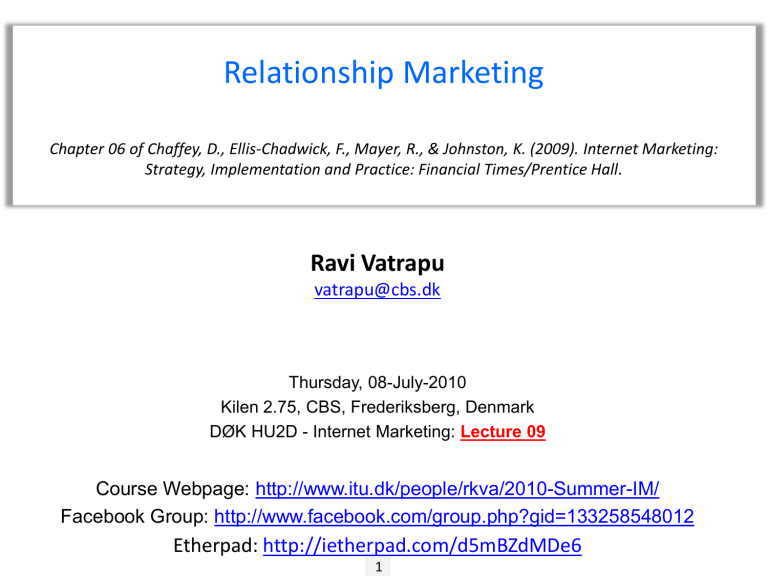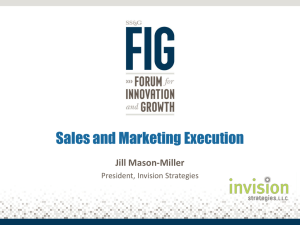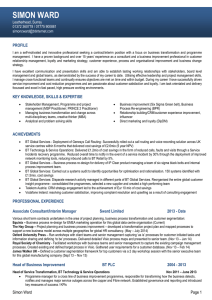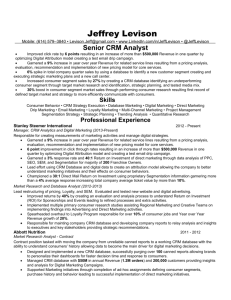Internet Marketing

Relationship Marketing
Chapter 06 of Chaffey, D., Ellis-Chadwick, F., Mayer, R., & Johnston, K. (2009). Internet Marketing:
Strategy, Implementation and Practice: Financial Times/Prentice Hall.
Ravi Vatrapu vatrapu@cbs.dk
Thursday, 08-July-2010
Kilen 2.75, CBS, Frederiksberg, Denmark
DØK HU2D - Internet Marketing:
Lecture 09
Course Webpage: http://www.itu.dk/people/rkva/2010-Summer-IM/
Facebook Group: http://www.facebook.com/group.php?gid=133258548012
Etherpad: http://ietherpad.com/d5mBZdMDe6
1
Transactional vs. Relational Marketing
2
Elements of CRM
Figure 6.1
Linkages between customer relationship management and related marketing approaches
3
CRM Applications
Sales force automation
Customer service management
Managing the sales process
Campaign management
Analysis
4
CRM Data
Personal and profile data
Contact details
Preferences
Transaction data
Sales history
Communications data
Campaign history
Research/Feedback/Support queries
Contact reports (B2B)
5
C USTOMERS AND V ALUE
Figure 6.2
Categorising customers according to value
6
E-CRM Benefits
Customer development
Managing e-mail list quality
Implementing e-mail marketing
Data mining
Personalisation and customisation
Customer service quality and multi-channel experience
7
CRM Activities
Figure 6.4
The four classic marketing activities of customer relationship management
8
The Five Is
Identification – can the customer be recognised for different channel contacts?
Individualisation – can communications and products be tailored?
Interaction – are communications two-way?
Integration – is there a 360 degree view of the customer?
Integrity – is the relationship built on trust?
9
Customization and Personalization
Figure 6.5
Options for mass customisation and personalisation using the Internet
10
Permission Marketing
Key concepts
Not interruption marketing
Not SPAM
Requires opt-in (online to e-mail)
Opt-out
Learning about the customer
Initial and continued relationship is based on incentives
11
Online Permission Marketing
Figure 6.6
A summary of an effective process of permission-based online relationship building
12
Customer Touch Points
Figure 6.8
Matrix of customer touch points for collecting and updating customer e-mail contact and other profile information
13
Segmentation Variables
Figure 6.9
The extent to which different types of segmentation variables tend to be predictive of response
14
IDIC Framework
Figure 6.10
The elements of the IDIC framework
15
Lifetime Value Creation
Figure 6.13
Different representations of lifetime value calculation
16
LTV-Based Segmentation Plan
Figure 6.14
An example of an LTV-based segmentation plan
17
RFM Analysis
Figure 6.15
RFM analysis
18
RF Analysis Example
Figure 6.16
Example of RF analysis
Source: Patron (2004). Reprinted permission of Macmillan Publishers Ltd: Interactive Marketing , Mark Patron, Case Study: Applying RFM Segmentation to the SilverMinds
Catalogue, vol. 5 , issue 3, 9 January, © 2004, published by Palgrave Macmillan. (The new name of this journal is Journal of Direct Data and Digital Marketing Practice .)
19
Quality, Satisfaction, and Loyalty
Figure 6.20
The relationship between service quality, customer satisfaction and loyalty
20
D
ISCUSSION
21











